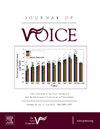Methods of Measuring Laryngeal Muscle Tension in Patients with Muscle Tension Dysphonia: A Scoping Review
IF 2.4
4区 医学
Q1 AUDIOLOGY & SPEECH-LANGUAGE PATHOLOGY
引用次数: 0
Abstract
Background
In clinical practice and research relating to Muscle Tension Dysphonia (MTD), several laryngeal muscle tension measurement methods are used to diagnose, to identify specific muscle strengths and deficits, and to measure therapeutic outcomes. The variety and reliability of available measurement methods presents challenges within diagnosis and treatment. The lack of methodical standardization presents a barrier to homogeneous practice in this area. There is a need for a comprehensive scoping review of laryngeal muscle tension measurement methods.
Study Design
Scoping review.
Objectives
(1) To identify current methods of laryngeal muscle measurement which have been developed or tested with people with MTD; and (2) To identify the construct/s measured, reliability, validity, ability to detect change, efficiency and accessibility of identified methods.
Method
This scoping review was conducted using the Arksey and O'Malley framework. Studies were identified through searches of 4 major databases. The reviewer independently assessed titles, abstracts, and full-text articles.
Results
Twenty seven papers published from 2000 to 2022 that satisfied the inclusion criteria were selected from 194 studies. The papers showed a variety of approaches with regards to the measurement of laryngeal activity and tension in subjects with MTD. Just over a quarter (25.9%) were reviews of the validity of assessment methods of MTD, including surface electromyography (sEMG), while 22.2% discussed surface electromyography as a measurement of muscle activity in subjects with MTD. 96.3% used a published methodological framework.
Conclusions
Assessment methods for Primary MTD are multifaceted, including patient history, laryngoscopic examination, and voice-related musculoskeletal features. Potential use of objective measurement methods, including sEMG, Real Time Elastosonography, Magnetic Resonance Imaging was noted. Due to variability in assessment methods and results, there is a need for greater objective practical methodological standardization to ensure accurate diagnosis, appropriate care, and chart patient progress.
肌张力性发声障碍患者喉肌张力测量方法综述
在与肌张力性发声障碍(MTD)相关的临床实践和研究中,有几种喉肌张力测量方法被用于诊断、识别特定的肌肉力量和缺陷,并测量治疗结果。现有测量方法的多样性和可靠性对诊断和治疗提出了挑战。缺乏有条不紊的标准化对这一领域的同质化实践构成了障碍。有必要对喉肌张力测量方法进行全面的范围审查。研究设计范围审查。目的(1)确定目前已开发或对MTD患者进行测试的喉肌测量方法;(2)确定所确定方法的测量结构、信度、效度、检测变化的能力、效率和可及性。方法采用Arksey和O'Malley框架进行范围综述。通过对4个主要数据库的检索确定了研究。审稿人独立评估标题、摘要和全文文章。结果从194篇文献中筛选出2000 ~ 2022年发表的符合纳入标准的论文27篇。这篇论文展示了多种方法来测量MTD患者的喉部活动和张力。超过四分之一(25.9%)的研究回顾了包括表面肌电图(sEMG)在内的MTD评估方法的有效性,而22.2%的研究讨论了表面肌电图作为MTD受试者肌肉活动的测量方法。96.3%使用已发表的方法框架。结论原发性MTD的评估方法是多方面的,包括患者病史、喉镜检查和与声音相关的肌肉骨骼特征。指出了客观测量方法的潜在用途,包括肌电图、实时弹性超声、磁共振成像。由于评估方法和结果的可变性,需要更客观实用的方法标准化,以确保准确的诊断,适当的护理,并记录患者的进展。
本文章由计算机程序翻译,如有差异,请以英文原文为准。
求助全文
约1分钟内获得全文
求助全文
来源期刊

Journal of Voice
医学-耳鼻喉科学
CiteScore
4.00
自引率
13.60%
发文量
395
审稿时长
59 days
期刊介绍:
The Journal of Voice is widely regarded as the world''s premiere journal for voice medicine and research. This peer-reviewed publication is listed in Index Medicus and is indexed by the Institute for Scientific Information. The journal contains articles written by experts throughout the world on all topics in voice sciences, voice medicine and surgery, and speech-language pathologists'' management of voice-related problems. The journal includes clinical articles, clinical research, and laboratory research. Members of the Foundation receive the journal as a benefit of membership.
 求助内容:
求助内容: 应助结果提醒方式:
应助结果提醒方式:


